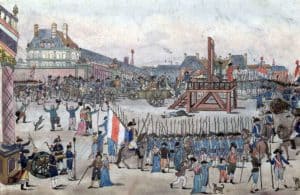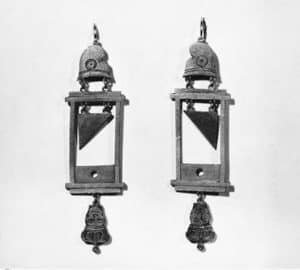When Was The Guillotine Last Used
10 Insane (just truthful) Facts About the Guillotine
*Originally written by Eve in June 2018 and updated by Arielle in Nov 2019
The guillotine is by far ane of the most gruesome methods of execution. Also known as: Madame la Guillotine, la Dame (the Lady), la Veuve (the Widow), le Rasoir National (the National Razor), and Louisette, the guillotine is synonymous with 'the Terror' of the French Revolution, and information technology continues to both horrify and fascinate the states.
Some of these facts may surprise yous. For example, did you lot know that the famous French figure Marie Antoinette was sentenced to expiry and executed via guillotine bract right in the middle of Place de la Concorde?
In this article, nosotros're going to delve into some grisly facts nearly the device…

ane. It was not actually invented by Dr. Joseph-Ignace Guillotin
Though his proper noun is linked with the device, Dr. Joseph Guillotin (French doctor, politician and humanist) did non invent it rather he aided in the cosmos. Guillotin was actually against the death penalty, but seeing as his colleagues were not peachy on abolishing it, he then advocated pain-costless methods of execution. Truthful to the founding principles of the Revolution: Liberté, Egalité et Fraternité (Liberty, Equality and Fraternity), he believed that everyone should exist treated as in life as in decease.
Prior to the Revolution peasants convicted of crimes were tortured and hanged, while their aloof counterparts were dispatched swiftly, and mercifully, by a swordsman. Even in death peasants couldn't get a break! The Guillotine was seen as 'the great blaster' as well as the defender of Revolutionary principles.
Guillotin worked with Dr. Antoine Louis (French surgeon) and Tobias Schmidt (a German artisan and harpsichord manufacturer) to design the starting time epitome, and it is actually credited as being invented by Dr. Louis, hence the common other nickname Louisette.
Guillotin's relatives were so embarrassed that their family name was associated with decapitation that they requested for the device'south proper name to be changed. Upon the French government's refusal, the Guillotin family changed their own name.

2. It wasn't the first decapitation device
Since the Eye Ages the British had been using a decapitation device dubbed the 'Halifax Gibbet'. The first recorded use of the Halifax Gibbet was in 1286 in Halifax, England.
The gibbet differs from the guillotine in that a rope must exist cut for the bract to descend. Complications arose due to the crescent shape of the blade, unlike its angled guillotine counterpart. (I don't even want to get into the horrors that ensued with a rounded blade…. suffice it to say, angled is better for anybody concerned.) The last recorded use of the Halifax Gibbet was in 1650. The Scottish also had a similar device called the 'Maiden' that was commencement used in Edinburgh in 1564.

3. People booed after witnessing the first public guillotining
Many people turned up at Identify de Grève (now identify de l'Hotel de Ville, Paris) out of marvel on April 25, 1792 to witness the offset public execution using the new mechanized device. Nicolas Pelletier had been sentenced to decease for theft and violently resisting arrest. The crowd was not at all impressed with the anti-climactic swiftness of the blade. In a few seconds, it was 'game over', and they felt cheated out of a few hours of entertainment. (Unremarkably public executions included torture and hanging.) The crowd wasn't won over by the 'modern machine' and they even booed executioner, Charles-Henri Sanson.
People were used to witnessing gruesome acts of horror that made the guillotine a humane way to go. Before the guillotine became the tool for execution, things were done differently, and much more violently (I know, it's hard to imagine something more violent than decapitation by falling bract, only it'due south true.)
As mentioned to a higher place, wealthy people were executed in less brutal ways such every bit hanging. Poor people and peasants who committed crimes, however, were actually tortured in some of the most horrific ways possible. Ever heard of quartering? This is when the accused is tied to the dorsum of a horse, dragged into town, and and then his limbs are tied to four separate horse carriages. You tin imagine what happens adjacent, and people were there to picket it all go downward.
This is why people were and so disappointed when they came to witness a public execution. Information technology's quite disturbing, but role of the entertainment was watching the accused suffer, and the guillotine prevented such suffering from occurring.

four. Guillotine earrings and toys for the kids?
During the peak of the outset French Revolution, executions were so frequent in Paris that they attracted large crowds. People fifty-fifty brought their children to witness these events, and industry popped upwardly around the scaffolds. There were food booths and leaflets were printed list the names of the condemned every bit macabre souvenirs. (Kind of like French Revolution-execution Pokémon. 'Got to grab them all'?) A grouping of older ladies called 'les Tricoteuses' (the knitters) would spend the whole twenty-four hour period knitting while watching the blade crash.
Some fervently patriotic ladies actually wore guillotine earrings, and miniature working guillotines were a hit with both adults and children alike.

The Nazis during the occupation of France – Courtesy of Wikimedia Commons
v. Nazis slaughtered over 16,000 people past guillotine
We commonly associate the guillotine with the severe brutality of the French Revolution. xvi,549 men and women were executed by the guillotine. However, did you know that the Nazis actually used the guillotine when during the 12 horrifying years they were in power? It has been claimed that the Nazis beheaded near as many victims every bit during the French Reign of Terror…
Hitler ordered the guillotine equally a method of execution in the 1930s, and ordered that 20 of the machines be placed in cities beyond Germany. According to Nazi records, the guillotine was somewhen used to execute some 16,500 people between 1933 and 1945, many of them resistance fighters and political protesters.
If yous thought this couldn't get more agonizing, it does. The Nazis even charged the families of those they had imprisoned and beheaded, sending invoices to the families of the deceased.

half dozen. Information technology was briefly 'banned' from 1906 – 1909
There was a growing unease nearly capital punishment in French society in the early twentyth century. President Armand Fallières (who was very much against capital punishment) pardoned all of those who had been previously sentenced to death, and this caused a public outcry.
The newspaper 'Le Petit Parisien', which was pro-uppercase punishment, polled their readers near the death penalty. They received one 412 347 responses in total, and the results indicated that 74% of readers were pro-guillotine. This naturally helped the anti-abolitionist crusade going into the referendum of 1908. The votes were 330 in favour of the death punishment, and 201 against. The French people and elected officials had spoken, they wanted 'Madame la Guillotine' back.
The Chief Executioner of France at the time, Anatole Deibler, nicknamed 'Monsieur de Paris' (the man from Paris), had been out of a job for three years due to the Presidential pardons. Deibler sold champagne to make a living. In 1909, he resumed his role as Chief Executioner of France until his decease in 1939.

7. The last public execution in France took place in 1939
Eugen Weidmann and two other men were implicated in a series kidnapping, robbery and murder ring. Their victims were primarily tourists visiting Paris. The subsequent trial was gruesome, sensational, and turned into a media circus. Weidmann was found guilty, and sentenced to decease for his crimes. A large oversupply gathered on the morning of June 17, 1939 exterior of the Saint-Pierre Prison in the town of Versailles to witness the spectacle. Instead of the usual silence and solemnity, they were bouncy and quasi-hysterical. After the execution was carried out, members of the frenzied crowd launched themselves onto the claret-soaked ground in order to dab various items in it for macabre souvenirs. Adding to the scandal, it was afterwards discovered that the execution had been secretly filmed.
Traditionally, public executions were meant to show the perils and direct consequences of disobeying the law. President Albert François Lebrun said that Weidmann'south execution had awakened the base animal instincts of the people and created a mob mentality. It was the last public execution via guillotine to accept place in France.

viii. The end of capital punishment in France
France's love/ hate human relationship with the guillotine ended in 1981 with the abolition of capital punishment.
The last execution using the guillotine took place on September 10, 1977. Hamida Djandoubi was charged with the torture and murder of a Élisabeth Bousquet, he was plant guilty of those crimes, and was sentenced to death. The execution was carried out in the courtyard of Baumettes prison house in Marseilles, and was officiated by Marcel Chevalier (France's last executioner).
How crazy is it to think that simply a piffling over 40 years ago people were still being executed past decapitation?
9. 7 Seconds 'til expiry
Perhaps the guillotine was a piffling 'as well practiced' at its task due to the swiftness and efficacy of the bract. The head of the victim would autumn into a basket at the foot of the device, whereupon the executioner would hold upward the head of the victim for the crowd. There were numerous reports of facial twitches, middle and lip movements in the severed heads.
In the 1950s French doctors Piedelievre and Fournier concluded that decease past guillotine was not as instantaneous as previously idea. In the following decades, research connected using rats to measure brain function after decapitation.
The conclusion is that after a swift decapitation, it will take seven seconds before the brain ceases to function due to blood and oxygen deprivation.

10. You can actually go meet the terminal guillotine blade in Paris
A guillotine bract that was used during the commencement French Revolution at Place de Grèves (at present place de l'Hotel de Ville) tin exist viewed at the Police Museum (Musée de la Préfecture de Police), located on the third flooring of an active police station in the Latin Quarter. The museum is i of Paris' many subconscious gems, and explores the history of France's police force forcefulness, capital punishment, and traces the advancement of criminal offence detection technology.
Musée de la Pr éfecture de Police
Location: 4, rue de la Montagne Sainte-Geneviève – 75005 PARIS, 3rd Flooring
Hours of Operation: Monday – Friday (nine:30 p.m. – 5 p.1000.) and the third Sat of every calendar month (10:30 a.m. – 5:xxx p.m.)
Cost: 0
Metro: Maubert-Mutualité, line x
Map:
We promise yous enjoyed reading some of these grisly yet interesting facts virtually a device that represents France during a dark period of the by. It's an interesting juxtaposition when we think about the fashion we run into France at present, and how we associate romance, calorie-free, beauty, and amuse instead of death and gore as it was viewed during the French Revolution.
Encounter you shortly in Paris! Don't hesitate to contact usa if you need farther information about anything! Y'all can also get out a comment and we will happy to answer you lot.
Are you lot in Paris now or coming soon? Notice Walks run innovative and fun walking tours in Paris. Montmartre, The Latin Quarter, The Marais… we become everywhere!
When Was The Guillotine Last Used,
Source: https://www.discoverwalks.com/blog/10-grisly-facts-about-the-guillotine/
Posted by: lovelandlosting.blogspot.com


0 Response to "When Was The Guillotine Last Used"
Post a Comment